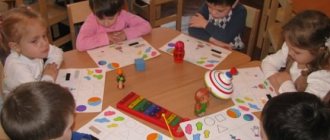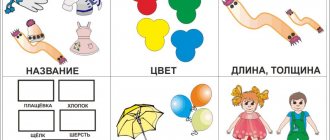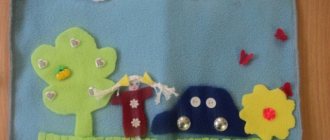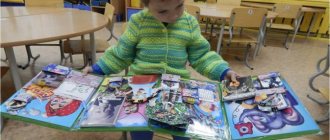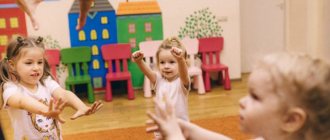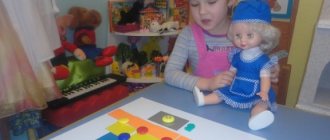Using ICT in working with preschoolers
Use of ICT
in working with preschoolers
Modern information technologies are increasingly being introduced into our lives and are becoming a necessary part of modern culture. It's no secret that the material that is interesting to the child is well absorbed. The computer carries a figurative type of information that is closest and most understandable to preschoolers. Movement, sound, animation attract children's attention for a long time. Children receive an emotional and cognitive charge that makes them want to look at, act, play, and return to this activity again.
Modern technologies for transmitting information open up completely new opportunities for teachers in the field of education. Psychologists recommend using all the main human sensory systems in learning - visual, auditory and kinesthetic (bodily). It must be said that the teacher was previously very limited in creating an emotional and meaningful background. Most often, he only had at his disposal a thematically designed group, posters or maps. He wrote the cognitive component of the material on the board or showed it on teaching aids.
A teacher can and should use new technologies in work in all areas of his activity. The use of Internet resources significantly expands the possibilities of obtaining high-quality and necessary information, which makes it possible to increase the effectiveness of both pedagogical activities with children and work with parents. Access to the Internet makes it possible to learn from the work experience of other preschool teachers, and to get an answer to a question from a specialist who is not at the preschool (for example, a psychologist, social teacher).
The use of multimedia technologies in preschool educational institutions is becoming a powerful technical teaching tool; it is a huge help for teachers in developing educational activities, holidays, producing manuals, preparing information for parents, maintaining documentation, and preparing reports. Modern information technologies give us the opportunity to exchange experiences, get acquainted with periodicals, and select the necessary material for educational activities. Thus, ICT has widely entered into preschool education. It is impossible to carry out educational activities without using visual aids. Our experience has shown that educational activities using multimedia equipment have advantages over traditional methods.
Benefits of using ICT:
1. Information on the screen in a playful manner arouses great interest;
2. Movement, sound, animation attract the child’s attention for a long time;
3. The figurative type of information is understandable to preschoolers who cannot read and write;
4. The acquired knowledge remains in memory for a long time and is easier to reproduce for application;
5. The ability to simulate situations that cannot be seen in everyday life.
Of course, this does not mean that the use of information technology is limited to teaching children how to use a computer. This is only a means to make educational activities varied, rich, and the child becomes a direct active participant in it.
Objectives of multimedia presentations
Thus, the use of multimedia presentations allows you to solve the following didactic tasks:
1. Systematize acquired knowledge;
2. Create motivation for learning;
3. Expand children’s vocabulary and their knowledge about the world around them;
4. Form a sound culture of speech;
5. Teach elements of literacy;
5. Develop perception, memory, attention, thinking, creativity.
The use of multimedia presentations in educational activities makes it possible to build the educational process on the basis of psychologically correct modes of functioning of attention, memory, mental activity, humanization of the content of learning and pedagogical interactions, reconstruction of the learning and development process from the standpoint of integrity
The basis of any modern presentation is to facilitate the process of visual perception and memorization of information with the help of vivid images. The forms and place of use of a presentation (or even a separate slide) in a lesson depend, of course, on the content of this lesson and the goal set by the teacher.
The use of multimedia presentations makes it possible to make educational activities emotionally charged, attractive, arouses keen interest in the child, and is an excellent visual aid and demonstration material, which contributes to the good performance of the lesson.
In our work, the following main areas of computer application have developed:
1. Preparation of didactic material; e-books; training programs on CD and DVD; audio and video materials.
2. Group documents.
3. Using multimedia presentations in working with preschoolers:
- Speech development
- All portraits of writers, poets, artists are available in electronic form;
- Presentations on the lexical topics being studied;
- Videos on the topic: “Oral folk art”, “Parade of fairy-tale characters”, “Biographies of Russian children’s writers”.
- Presentations and simulators on FEMP:
- Presentations on the topics studied;
- Video and photo materials to form a holistic picture of the world.
- "Animals of the North"
- "Nature of the native land"
- "7 wonders of Novokuznetsk"
- “Symbols of our state” (etc.)
Thus, the use of multimedia presentations in educational activities on FEMP ensures the activity of children when viewing, examining and visually identifying the signs and properties of objects; methods of visual perception, examination, and identifying qualitative, quantitative and spatio-temporal signs and properties in the objective world are being developed; visual attention and visual memory.
When using multimedia presentations in speech development classes for preschoolers, their interest increases significantly and the level of cognitive abilities increases. Multimedia presentations make it possible to present educational and developmental material as a system of vivid supporting images (for example: an illustrated dictionary for the development of children’s speech and story albums that are designed to increase children’s vocabulary, didactic games and exercises, a variety of illustrative material).
We widely use presentations in educational activities to form a holistic picture of the world; they make classes more emotional, attractive, arouse keen interest in the child, and are an excellent visual aid and demonstration material, which contributes to good lesson performance.
Multimedia presentations, including animation, bright visuals, music and video effects with an interesting plot, are able to hold the attention of the most restless preschoolers. With the help of such techniques it is easy to create an atmosphere of travel, a walk, show the beauty of your native nature, city, etc.
Also, the use of ICT is very effective when working individually with children.
With the help of videos and multimedia presentations, children learn articulation gymnastics complexes. Exercises or pictures appear on the monitor screen - symbols of various exercises. Children are happy to complete the proposed material while looking at the screen.
The speech therapist teacher uses multimedia presentations in individual and frontal work with children.
This activates the cognitive activity of children. Game components included in multimedia programs activate the cognitive activity of children and enhance the assimilation of material. The use of presentations and computer games in joint activities with preschoolers who have general speech underdevelopment helps to increase the effectiveness of the correctional educational process. Children develop impaired articulatory skills faster, the time required for correctional work to introduce assigned sounds into speech is reduced, self-control over pronunciation is developed, vocabulary is activated, the grammatical structure of speech, coherent speech, and mental processes are improved.
Computer tools make it possible to introduce a visual effect into educational activities, increase motivational activity, and contribute to a closer relationship between the teacher-speech therapist and children. In the use of multimedia presentations and games by a speech therapist, one can highlight such advantages as information capacity, compactness, accessibility, clarity, emotional appeal, mobility, and versatility.
Thanks to the sequential appearance of images on the screen, children, when working individually, have the opportunity to perform exercises more carefully and fully. The use of animation and surprise moments makes the correction process interesting and expressive. Children receive approval not only from the speech therapist, but also from the computer in the form of prize pictures accompanied by sound design.
A harmonious combination of traditional means and the use of presentations, games, and interactive exercises can significantly increase children’s motivation to learn and, therefore, significantly reduce the time it takes to overcome speech disorders.
The use of multimedia presentations in correctional work prevents children from becoming tired, supports cognitive activity in children with various speech pathologies, and increases the efficiency of speech therapy work in general. Their use in speech therapy classes is interesting, educational and exciting for children. The screen attracts attention, which we sometimes cannot achieve when working with children from the front.
However, I would like to note that the use of computer tasks does not replace the usual correctional methods and technologies of work, but is an additional, rational and convenient source of information, clarity, creates a positive emotional mood, motivates both the child and his mentor; thereby speeding up the process of achieving positive results at work.
When working with parents, we use multimedia in the design of visual materials, during parent meetings, round tables, and project activities. We involve parents in preparing multimedia material for their children to perform in front of their peers. The use of modern technologies makes it possible to diversify communication (joint activities, holidays and games), to increase the interest of adults in receiving useful information about raising children and how the child spends his time in kindergarten.
The following positive factors indicate the effectiveness of the use of ICT:
- children began to better perceive the material being studied due to the fact that the presentation contains a figurative type of information that is understandable to preschoolers who cannot read and write;
— pupils’ motivation for learning activities increased due to the attractiveness of the computer and multimedia effects. Movement, sound, animation attract children's attention for a long time;
— children’s acquired knowledge remains in their memory for a longer period of time and is easier to restore for practical use after a short repetition;
- presentations allow you to simulate such life situations that
cannot be seen in everyday life (rocket flight or satellites, transformation of a pupa into a butterfly, etc.).
So, the use of information technology makes it possible to make the process of learning and development of a preschool child quite simple and effective, significantly saves the teacher’s time, improves the culture of the lesson, allows for a differentiated approach to students, contributes to the formation of interest in the subject and, therefore, has a positive effect on the quality of education of preschoolers .
Thus, information and communication technologies can significantly increase the efficiency of the educational process and solve the problems facing an educational institution in raising a comprehensively developed, creatively free individual.
MAGAZINE Preschooler.RF
“ICT in the pedagogical activities of kindergarten teachers”The use of information and communication technologies in kindergarten is a pressing problem of modern preschool education. Gradually, computer technologies are entering the preschool education system as one of the effective ways to transfer knowledge. This modern method develops interest in learning, fosters independence, develops intellectual activity, allows development in the spirit of modernity, and makes it possible to qualitatively update the educational process in preschool educational institutions and increase its efficiency.
When using ICT in work, the work experience of teachers and education are not important, but the desire and desire to master ICT is important.
The use of computer technology helps teachers in their work:
- attract passive listeners to active activities;
- make educational activities more visual and intensive;
- activate cognitive interest;
- implement student-centered and differentiated approaches to learning;
- to discipline the teacher himself, to form his interest in work;
- activate thought processes (analysis, synthesis, comparison, etc.);
- ICT will allow the teacher to communicate more widely at various teaching events, for example, video master classes, webinars, etc.
- work with paper media is significantly reduced, since almost all text information is compiled and stored in electronic form, etc.
The use of information and communication technologies in preschool education allows one to expand the creative capabilities of the teacher and has a positive impact on various aspects of the mental development of preschool children. Developmental activities using it become much brighter and more dynamic. The use of computer technology makes it possible to make GCD attractive and truly modern, to solve cognitive and creative problems based on clarity.
During the play activities of a preschooler, using computer tools, he develops: theoretical thinking, developed imagination, the ability to predict the outcome of an action, design thinking qualities, etc., which lead to a sharp increase in children’s creative abilities.
The range of use of ICT in the educational process is quite wide. One of the most successful forms of preparing and presenting educational material for joint organized activities in kindergarten is the creation of multimedia presentations. It facilitates the process of perceiving and remembering information with the help of vivid images, because combines dynamics, sound and image, i.e. those factors that hold the child’s attention for the longest time. Simultaneous impact on the two most important organs of perception (hearing and vision) allows you to achieve a much greater effect. And the English proverb says: “I heard and forgot, I saw and remembered .
| Next > |
Application of computer technologies in modern education of preschool children
The work describes the teaching of an element of computer graphics, which develops creative abilities, making it possible to improve the computer literacy of preschoolers, develops intelligence and contributes to general preparation for school.
Keywords : preschool education, preschool age, computer, graphics, information, games, creativity, technology
The Geekbrains computer literacy course is a program for a confident look into the future, the basis for comprehensive development and complete independence. Helps in mastering programs such as Excel and Word, search engine, mail and Zoom.
What knowledge will be gained:
- Children will master safe computer skills, work with Microsoft Office, browsers and websites useful for life;
- learn to make decisions for practical problems;
- create presentations and their own email, and protect personal information on the Internet.
You will find productive webinars, theoretical and practical classes in online and offline format, structured presentation of material, and constant supervisory support from world-class teachers.
Come, it will be educational not only for beginners!
Today, computer technology can be considered a new way of transferring knowledge that corresponds to a qualitatively new content of children’s learning and development. This method allows the child to learn with interest, find sources of information, fosters independence and responsibility in acquiring new knowledge, and develops the discipline of intellectual activity [1]. Scientists' opinions about the influence of computers on children's development are very contradictory. And this is no coincidence, because a computer, like almost any object in our reality, can be both useful and harmful - depending on whose hands it is in and what role it plays in a person’s life.
Most preschool children use a computer for entertainment purposes, that is, they play computer games, occasionally resorting to the help of adults. Some children are passionate about educational and educational games, as well as arcades, racing, and games to develop reaction speed. Thus, modern preschoolers spend from half an hour to two hours a day in front of a computer monitor, but this time is not used rationally enough from the point of view of training, education and the development of the child’s full-fledged creative personality.
To correct this situation, it would be more expedient to teach preschoolers to use a computer to create a product of creative activity. For example, use programs for creating graphic images, involve preschool children of their parents in project activities using computer information technologies, encourage the child to use the computer as a tool for creativity, thereby distracting him from excessive passion for computer games. Teaching the elements of [2] computer graphics develops creative abilities, making it possible to improve the computer literacy of preschoolers, develops intelligence, and contributes to general preparation for school.
In a preschool educational institution, a computer is [3] a tool for demonstrating presentation materials that develop the attention and imagination of children, and in art classes, a computer is primarily considered as a tool for creating a graphic image invented by a child. At preschool age, children have a well-developed imagination, and it is much faster than the development of fine motor skills and hand coordination. Very often, a child cannot express the image he has invented on paper using ordinary graphic materials: paints, crayons, pencils, felt-tip pens, etc. Teachers and parents are familiar with the disappointment of children because the circles they drew are not round, the lines are not straight enough, the houses are crooked, and the paint has spread across the sheet and everything is ruined. Computer graphics programs not only provide the young artist with a set of geometric figures of ideal shape and various ways of painting an image with color, but also allow you to cancel an unsuccessful action, correct the drawing as many times as you please, and achieve a result that meets strict requirements! a little author and increasing his self-esteem.
In the first lessons on computer graphics with children of senior preschool age, special attention should be paid to the computer, electronic equipment, the names of the parts and the principle of their operation. Children are invited to examine and draw, together with the teacher, a computer with a monitor, keyboard, mouse, speakers and system unit. By means of a graphic image, the names of the computer components and their relationships are clearly shown and fixed. Rules of behavior in a computer class and safety precautions when working at a computer are discussed. Particular attention is paid to correct posture and positioning of the legs when sitting at a computer desk, the position of the hands when working with the mouse and keyboard, and maintaining the required distance between the child’s eyes and the screen.
Despite the fact that many children play computer games at home, not everyone knows how to hold their hand on a manipulator correctly: many confuse the control buttons and the mouse wheel, move their hand with the manipulator too far, lift their elbow up, or try to hold the manipulator with both hands at once. hands. At first, it is difficult to get the pointer to the desired point on the screen. This is due to the poor development of fine motor skills in preschool children. As a result of several training sessions on painting fairly small details with the “fill” tool, moving selected objects around the screen and changing the size, this difficulty can be overcome - coordination of movements is significantly improved, which allows not only to cope with the tasks of a computer game, but also to prepare the child’s hand for writing .
When the child has learned to use the manipulator correctly, you can begin to introduce the names and functions of the tools located on the panel of the graphic editor. Over the course of several lessons, children become familiar with the instruments one by one, then learn to create simple compositions with their help. You can increase motivation to study the proposed set of tools by using competitive moments, test tasks, riddles, and puzzles.
After children have acquired the necessary skills and abilities to use a number of tools, they can move on to constructing an artistic image on a given topic: creating a landscape characteristic of different seasons, subject and subject drawing. The complexity of the task occurs due to an increase in the number of tools used and the addition of copying and reflection functions. It is also advisable to use the ability to select a scale: create an image on a large scale, then switch to a normal one and get a small detail for subsequent copying and thus compiling complex compositions. Mastering these techniques, along with the use of tools, helps prepare the child for independent work in creating an artistic image using computer graphics. The tasks should be designed for one lesson; in the next lesson, only coloring of a ready-made graphic image is allowed. This is due to the psychological characteristics of a child aged six to seven years, for whom it is difficult to retain a planned image in memory and not lose interest in it until the next lesson [1].
In this article we are talking about drawing on a computer only as a complement to traditional methods of teaching and upbringing; such activities in no way replace painting, drawing, modeling and appliqué, but complement them, enriching the pedagogical process with new opportunities. The use of computer technology in working with preschool children dramatically increases their motivation to learn. Using this quality, it is possible to rationally offer children those elements of knowledge that are difficult to understand and master under normal conditions using traditional means of didactics, as well as those types of creative tasks, the implementation of which in real material would be too labor-intensive or irrational [1].
Thus, the use of computer technologies in preschool age develops the child’s imagination and creative abilities. A good result is obtained by preliminary work on choosing the name of the future drawing, discussing the plot and drawing up pencil sketches on the chosen topic. The independent work of a preschooler to create a drawing on a computer allows us to hope that after completing classes he will be able to use the functions of graphics programs at home or at school, will become interested in computer graphics and will pay less attention to aggressive computer games.
Literature:
- Komarova T. S., Antonova A. V., Zatsepina M. B. Aesthetic education program for children 2-7 years old. - Moscow: Pedagogical Society of Russia, 2005. - P. 56-58.
- The use of computer technology in working with preschool children https://lib.exdat.eom/docs/l 240/index-11612.html
- Turyev S.V. Information computer technologies as an effective means in the educational process of children of senior preschool age // ITO-Troitsk Moscow, 2008. - P. 27-28.

